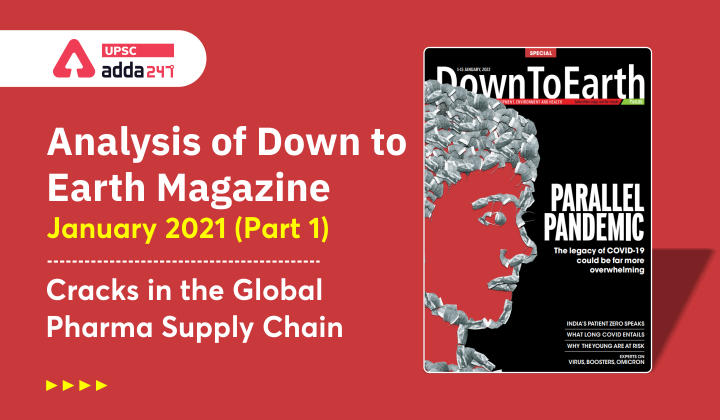Table of Contents
Relevance
”GS 3: Mobilization of Resources, Industrial Policy”
Introduction
- Weaknesses in the global pharmaceutical supply chain, exposed and exacerbated by the coronavirus pandemic, have led major markets to pursue localization policies aimed at bolstering domestic production capacity.
- The scramble for essentials like drugs and oxygen cylinders during the pandemic has laid bare the strain on the supply chain.
- The pharmaceutical industry has developed in a way that makes every country vulnerable during a crisis. As every country scrambles for medical essentials, it has enormously strained the global supply.
- At the same time, the scramble has also exposed a fault line in the global supply chain, created over the years by an industry that has flourished by putting profit before public health.
Infighting Within Countries
- As deep cracks appeared in the global supply chain of masks, personal protection equipment (ppe), testing kits, drugs and ventilators, this has triggered infighting within countries.
- In the US, the federal government has seized masks, thermometers and other essentials ordered by different states.
- In France, the government has requisitioned all available masks for its own use.
- Israel has deployed its intelligence agency, Mossad, to take control of all ventilators in the country.
What Happened in India during the Second Wave of Covid-19?
- NITI Aayog on April 3 estimates that India would need 27 million N95 masks, 15 million ppe, 1.6 million diagnostic kits and 50,000 ventilators within two months.
- India has further been pushed into the eye of the storm with experimental drugs like hydroxychloroquine (hcq) becoming part of the politics.
- As stocks of active pharmaceutical ingredients (apis)— basic therapeutic chemicals that act as raw materials for producing tablets, capsules and syrups—dwindled globally, India put 13 apis, also called bulk drugs, and their formulations on the restricted list for exports on March 3 and then banned their export on April 4.
- These accounted for 10 per cent of India’s total pharma export. The anti-malarial hcq was part of the list. But India was forced to lift the ban on humanitarian grounds. The US, in fact, threatened India with retaliation.
- On April 6, India’s Directorate General of Foreign Trade (dgft) had to permit the export of apis and formulations made from them. Export of formulations made from paracetamol was also allowed, though dgft continues to restrict the export of the api for paracetamol. This medicine for fever is part of the arsenal to provide relief to covid-19 patients.
Top challenges in the pharmaceutical supply chain in India
- The Indian pharmaceutical industry and the healthcare sector are preparing for the third year of outrageous pressure. Apart from dealing with the pandemic, pharmaceuticals and healthcare face several other challenges.
- The key challenge faced by pharmaceutical companies has been the shortage of key raw materials for manufacturing drugs. India imports 60% of APIs (Active Pharmaceutical Ingredients) and DIs (Drug Intermediates) and nearly 70% of this demand is met by Chinese companies (as of July 2020). This reliance to import cheaper raw materials from countries such as China is a result of lack of tax incentives, high cost of utilities, and low import duties in India.
- The Pharma supply chain is highly fragmented and there are many geographical areas that are operating with larger numbers of SKUs. On the other hand, there are areas, where even essential medicines are not available on time. This makes the whole process of supply chain management complex.
- Furthermore, restrictions on the movement of products and other goods also posed a problem for the pharma supply chain.
- There are over 300,000 brands and 300 new brands are launched every month. Thus the negative implications are reverse logistics, high rate of expiries and high employee turnover ratios compared to any other industry. This differentiates the Pharma supply chain to a large extent and hence, is one of the most complicated one.
- Dosage Protocol a Problem: Changing protocols kept doctors confused about the line of treatment. Many started experimenting, too. They say patients were reported to develop multiple ailments due to side effects of medicines, use of steroids and stoppage of regular medicines. The use of steroids while treating covid-19 had serious complications in comorbidity cases. In the case of diabetes, it was particularly serious.
Post-Covid 19- What is Next for Indian Pharma Sector?

How blockchain technology can help overcome supply chain crisis?
- The advantage of a blockchain-based system is that competitors can collaborate on a shared platform without sharing sensitive information, allowing them to trace the provenance of supplies, verify their status, and reduce friction throughout the supply chain.
- Blockchains are an ecosystem technology and only bring benefit when the technology is not only broadly adopted but when physical systems work with it. To make that happen, broadly adopted standards are necessary.
- This will most certainly not be our last global health crisis. Blockchains could not only help us increase agility during extraordinary black swan events, but also help us operate better in day-to-day operations.
- As we wake up to the fact that our health and economic welfare is interconnected with those thousands of miles away, it becomes clearer that we need to leverage our global resources to effectively fight large-scale problems. Blockchains could help us do this more safely and efficiently.



 TSPSC Group 1 Question Paper 2024, Downl...
TSPSC Group 1 Question Paper 2024, Downl...
 TSPSC Group 1 Answer key 2024 Out, Downl...
TSPSC Group 1 Answer key 2024 Out, Downl...
 UPSC Prelims 2024 Question Paper, Downlo...
UPSC Prelims 2024 Question Paper, Downlo...




